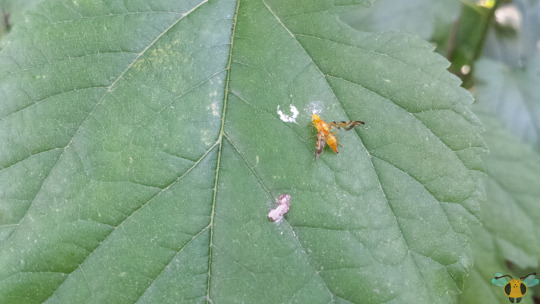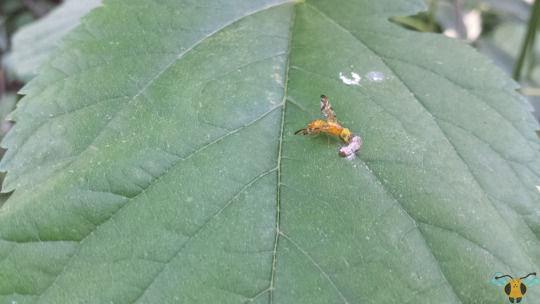#strauzia
Explore tagged Tumblr posts
Text
Never thought I would see a fly rocking a double mohawk before
Not exactly sure what this beaut is, but Strauzia genus was about as satisfactory as I did narrow it down.
2K notes
·
View notes
Note
Potato quality pic but WHOMST is this little guy who turned up at our warehouse? Western Pennsylvania 😍



As far as I can tell from these photos, it's a fruit fly in the genus Strauzia :)
42 notes
·
View notes
Text

Strauzia what now?
#This is legit something we just saw in our yard using iNaturalist#fly#inaturalist#seek#bugs#insects#flies#Strauzia longipennis
51 notes
·
View notes
Text








Yellow Fruit Fly - Strauzia perfecta
I'm thankful to once again find this specie, and I'm even more grateful to get a closer look at it without it skittishly escaping. Those "F-shaped" markings along the wings are as distinct as ever, but this individual seemed sluggish to be honest. Just as last time, this individual wasn't found on its reported host plant (Giant Ragweed). As such, it could have been hiding beneath a leaf to escape the heat of the day or to conceal itself from opportunistic hunters. It could have also been searching for a location to rest for the night (it was observed just after 8pm). After taking a few pictures, the leaves were returned to normal and this Fruit Fly was able to go about his business. Judging by the nub at the end of the abdomen (as opposed to a prominent ovipositor), this individual is likely to be a male. Assuming this identification is correct, this individual can offer some further insight into the behavior of these Flies, as males have an important function to carry out with regards to territoriality (see below). Since it been over a year since this insect has been explored, I've had a bit of time to research some of this Fly's relatives and their behaviors. It started as an exercise to separate the species of North America (for identification), but there was much more to learn.
Firstly, all Flies of the Strauzia genus share a similar form, so close observation is key to identification. As well, the wings alone cannot be used solely for identification, especially since the "F" marking and the patterns can be variable and only one North American specie is sexually dimorphic (that being S. noctipennis). Compared to his other close relatives like S. longipennis or S. intermedia, S. perfecta lacks significant markings along its body outside of a few sections of orange or the occasional spot. The easiest way to determine your Yellow Fruit Fly's identity however, is to find it on or near its host plant and observe it there. Males can be incredibly useful for this purpose as male Strauzia Flies are tasked to secure and defend a plant as their territory. As a result of his efforts, when a female Fly discovers the location, the plant can be untouched when (after a successful mating) its time to place their eggs in the giant ragweed's flowers. This gives the maggots the best chance to feed and develop within the stems and pith without interference from the offspring of other Flies. As such, it begs the question what was this Fly doing here? Was it one of the reasons mentioned above? Or perhaps is it still in the process of seeking out a giant ragweed plant to claim as its own?
Pictures were taken on June 21, 2024 with a Google Pixel 4.
#jonny’s insect catalogue#ontario insect#fly#strauzia perfecta#yellow fruit fly#fruit fly#diptera#insect#toronto#june2024#2024#entomology#nature#invertebrates#arthropods#photography#animals
5 notes
·
View notes
Text




i love this beautiful fly i saw earlier. th pix dont rly show how neon orange pink its eyes were
7 notes
·
View notes
Photo

possibly Sunflower Maggot Fly (Strauzia longipennis)
May 23, 2022
Southeastern Pennsylvania
#bug#bugs#photographers on tumblr#Strauzia longipennis#fruit flies#insect#insects#bugblr#fly#flies#entomology#diptera#nature#animals
148 notes
·
View notes
Text

I saw one of these today
When you're a bug fangirl and you find a weird ass bug outside and start fangirling
10K notes
·
View notes
Photo




Yellow Fruit Fly - Strauzia perfecta
Now here’s a strange sight: a bright-colored visitor to the backyard who seemingly has an interest in the bird droppings on this leaf. While the common name may suggest a different lifestyle, adult Fruit Flies consume sources of food other than fruits. Due to my presence, this yellow beauty didn’t stay on this leaf very long leaving ambiguity as to whether or not droppings are a preferred source of nutrients. From what I’ve found, the host plant of this specie is apparently the giant ragweed plant (Ambrosia trifida - which this leaf doesn’t belong to) making this insect a passerby in the backyard. Where their host plant is abundant, the adult Flies are drawn to the flowers where they can feed on nectar, pollen and anything else plant-related they can lap up with their mouthparts. More importantly, where one Fly arrives, others will also join, leading to potential mating and egg-laying opportunities. Here’s where the “fruit” part comes in: the Fruit Fly eggs will be laid on the ragweed flower, which gives the hatching larvae a direct line into the stem!
The larvae of this specie is a stem-miner which feeds on the innards of the ragweed stem. The worm-like maggot moves down the stem (feeding as it goes) until it reaches the roots and pupates in the nearby soil, awaiting emergence next year...which is what we’re witnessing with the adult here. A single generation year after year, but that’s more than enough if a sufficient source of giant ragweed can be found. As it stands, this Fly has to compete with the similar looking Picture-Wing Flies for resources in this yard. Though similar in appearance try not to confuse the two for one another. Though the wings are brightly colored and ornate, this is a case of Tephritidae vs. Ulidiidae. That being said, if you’re drawn to the wings, good! The wings provide a clue as to how to identify this insect successfully. If the body bears no substantial dark markings, has a yellow body (with maybe some orange) and the wings have a “F” shaped pattern, you’ve found S. perfecta! With the “F” marking, the top line will be wide and the bottom line with be thin and long; zoom in to see for yourself.
Pictures were taken on June 15, 2018 with a Samsung Galaxy S4.
#jonny’s insect catalogue#ontario insect#fly#strauzia perfecta#yellow fruit fly#fruit fly#diptera#insect#toronto#june2018#2018#entomology#nature#invertebrates#arthropods#photography#animals
2 notes
·
View notes